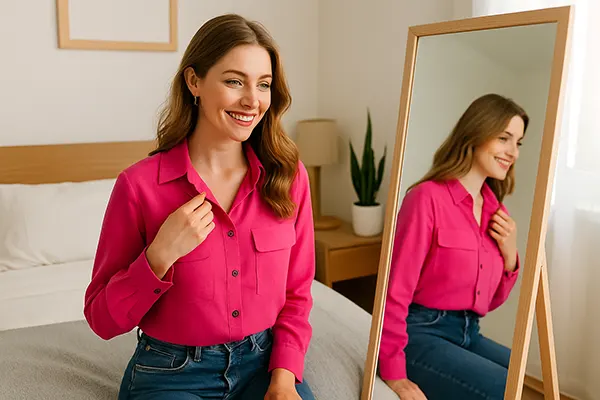
Style and Self-Expression: How Clothing Shapes Confidence and Mood
Clothing has long been more than just a way to cover the body — it is a reflection of personality, emotion, and identity. The choices we make when getting dressed each day reveal how we perceive ourselves and how we want to be seen by others. Understanding how style affects confidence and emotional well-being helps us appreciate fashion as a form of self-expression and self-care rather than vanity.
The Psychology Behind What We Wear
Studies in psychology and sociology confirm that the clothes we wear can influence how we feel and behave. Researchers from Northwestern University coined the term “enclothed cognition” to describe how certain garments can change our mindset and performance. For example, people wearing professional attire often report feeling more capable and assertive, while casual clothing may help individuals relax and reduce stress levels.
Colour also plays an important role. Warm tones like red or orange tend to boost energy and attract attention, while blue and green can promote calmness and focus. Therefore, choosing an outfit isn’t just about aesthetics — it’s about setting the tone for the day and aligning clothing with one’s goals and emotions.
Moreover, clothing serves as a psychological armour. When people wear clothes that fit their body and personality, they experience a sense of control and authenticity. This, in turn, strengthens confidence and self-acceptance, reinforcing the connection between outer appearance and inner state.
Clothing as an Extension of Identity
Every outfit we select tells a story about who we are or aspire to become. From minimalist neutrals to bold patterns, style communicates individuality. In modern society, where first impressions form quickly, the ability to express identity through fashion becomes a powerful tool for both personal and professional growth.
For instance, creative individuals often use fashion as an experimental canvas — mixing textures, layers, or vintage pieces to convey originality. On the other hand, those in corporate environments may rely on structured silhouettes and classic cuts to express professionalism and reliability. Both approaches highlight authenticity and purpose rather than trend-following.
Ultimately, the most impactful styles emerge when self-expression aligns with personal values. Whether elegant or eccentric, clothing that resonates emotionally enhances comfort and boosts confidence, proving that fashion is deeply intertwined with mental well-being.
The Emotional Connection Between Mood and Wardrobe
The link between mood and fashion is cyclical: how we feel influences what we wear, and what we wear can, in turn, affect how we feel. A study by the University of Hertfordshire revealed that people who wore clothes they associated with happiness experienced measurable improvements in mood throughout the day. This suggests that choosing uplifting garments can act as a simple yet effective form of emotional self-regulation.
For many, clothing offers comfort during difficult times. Wearing favourite colours, soft fabrics, or familiar styles can create a sense of stability. Conversely, bold or unconventional choices can inject excitement and motivation, helping individuals break routine or overcome insecurities.
Fashion also supports resilience. Dressing intentionally, even on low-energy days, sends a signal to the brain that one is prepared to face challenges. Such small acts of self-care strengthen emotional balance and help maintain a positive self-image.
Using Fashion for Mental Empowerment
Wardrobe choices can be used strategically to foster confidence and empowerment. Psychologists recommend using “power dressing” — selecting clothing that symbolises authority and competence — before important meetings or events. This technique helps to reinforce an assertive mindset and reduce anxiety.
Equally important is the concept of comfort confidence: when garments fit well and allow free movement, they eliminate distractions and promote a natural sense of assurance. Overly tight or ill-fitting clothes, on the other hand, can negatively affect concentration and self-esteem.
Mindful dressing practices, such as preparing outfits in advance and choosing pieces that reflect one’s current mood or aspirations, can strengthen emotional stability. When clothing supports identity and comfort, it transforms from a superficial choice into a personal empowerment tool.

Modern Trends in Style and Self-Perception
In 2025, the fashion landscape continues to move toward inclusivity, sustainability, and individuality. Consumers increasingly value brands that promote ethical production, diverse representation, and designs adaptable to different body types. This shift supports a more positive self-image across society, encouraging people to embrace their uniqueness.
Personal style is also being redefined by digital culture. Social media enables people to experiment with looks and find communities that validate their aesthetic identity. From gender-fluid fashion to slow fashion movements, trends today focus on authenticity and emotional connection rather than mass consumption.
Furthermore, technology contributes to self-expression through virtual wardrobes, AI styling apps, and personalised recommendations. These innovations help individuals explore new looks confidently while maintaining comfort and self-awareness — blending creativity with psychology in everyday life.
The Future of Clothing and Confidence
Looking ahead, fashion psychology is expected to gain even greater importance. Brands and designers increasingly collaborate with behavioural scientists to understand how clothing influences mental health and self-perception. As sustainability and well-being merge, style will serve not just as decoration but as a means of emotional empowerment and self-discovery.
Consumers are likely to prioritise emotional satisfaction over fleeting trends, choosing items that tell a story or hold personal meaning. This marks a cultural evolution where fashion becomes a tool for connection rather than competition.
Ultimately, the relationship between style, mood, and confidence reflects a universal truth: when we feel comfortable in our clothes, we feel comfortable in ourselves. The art of dressing, therefore, is not about perfection — it’s about authenticity, balance, and joy.
